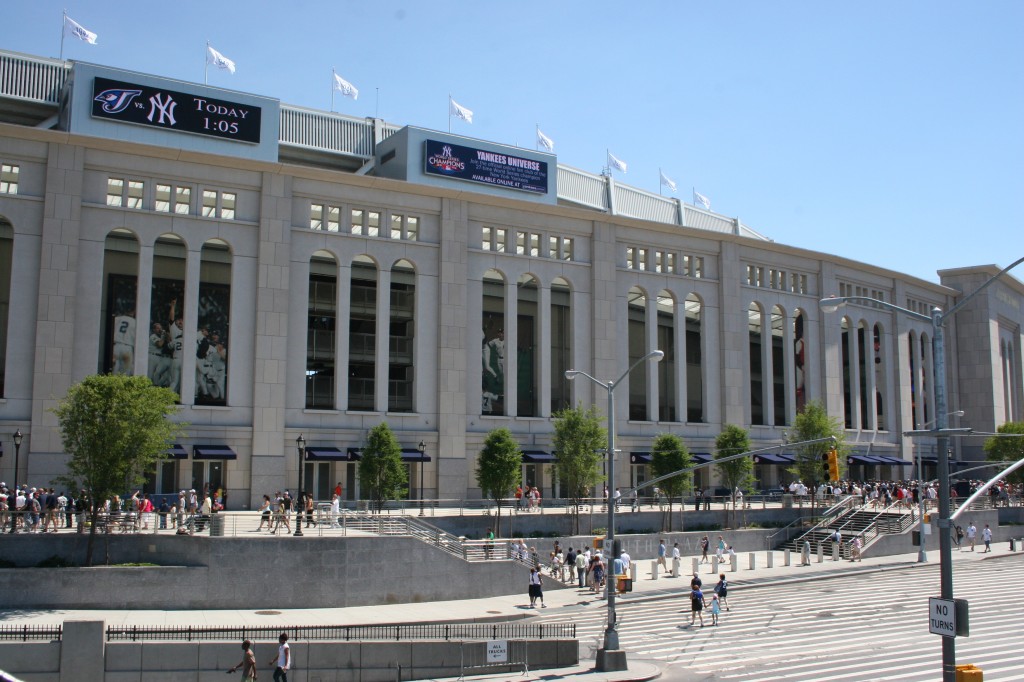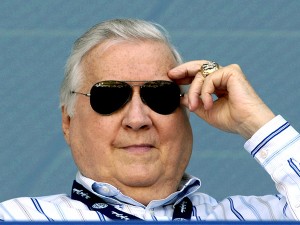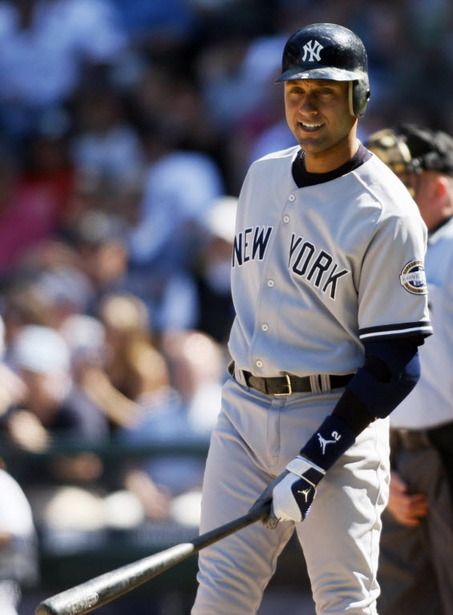Stadium Review: New Yankee Stadium
Visiting Yankee Stadium – the new one, that is – and watching the Pinstrippers host the Toronto Blue Jays was the focal point of my recent trip to the New York City. It was the fourth major league ballpark I’ve ever been to and easily the most awaited.
Opened in 2009, the so-called New Yankee Stadium was built across the street from the original Yankee Stadium. I had tried in vain to get tickets at the elder stadium before it was knocked down, but the only available tickets cost an arm and a leg through scalpers.
I missed out on the House that Ruth built, but did make it to the underwhelming House that Jeter built.
Don’t get me wrong, New Yankee Stadium has a lot going for it.
Architecturally, it’s beautiful. The ballpark stands as a monument to the impressive legacy of Old Yankee Stadium, mimicking many of the original field’s most distinctive qualities and emphasizing that this is the home of the most successful franchise in baseball history.
The architectural team of Populous insured that the dimensions of the field are exactly the same as the old park, although the new seating is slightly smaller the original field at 52,325 (including standing room) versus 56,936.
Also, as you can imagine, the New York Yankees know what they’re doing when staging a baseball game. Every little detail during the game was skilfully handled, from the anthems to the TV timeout features.
Charming touches abounded, especially when the Yankees’ current roster recited Lou Gehrig’s famous speech to commemorate the anniversary of his final game with the club.
And the food, my God, the food. Every stadium has a signature dish. Something that is distinctly theirs. At Yankee Stadium it’s garlic French fries with melted cheese. It’s gooey, salty, cheesey and above all else potent enough to guarantee some space on the subway ride home.
Populous did a lot to emphasize the history of baseball in New York City including moving Monument Park from the older building, creating a Yankee Museum and, of course, a centralized merchandise store off the stadium’s main concourse.
But that’s one of the key problems with New Yankee Stadium.
In their slavish devotion to replicating the style and design of the older building, they did little to improve on the old stadium. Yes, everything is new and shiny but facilities are few and far between.
As a result, there are long lines just about every step of the way. Crowds arrive early, so there is a long wait for most of the features of the park, especially Monument Park, the Yankee Museum and the merchandise outlet.
In fact, the line for Monument Park was cut off an hour and a half before the opening pitch because security personnel needed to be able to clear it out before game time. Same thing with the Yankee Museum – lines had to be cut off because they were so long.
I’ll allow that I went on Independence Day, when most of the crowd was probably from out of town and therefore more likely to go to the touristy corners of the stadium, but surely they could have predicted that those would be crowded sections of the stadium.
Instead, the entrance to Monument Park is in the middle of a cramped corridor. Compared to other contemporary stadiums like cross-town rival Citifield or Detroit’s Comerica Park, which put an emphasis on wide-open space and breezy walkways, it’s a confusing choice.
Ultimately, it’s worth going to Yankee Stadium to say “I’ve been there.” Visitors should expect high prices, long lines and cramped quarters. I would not want to be a Yankees fan and have to attend more than one game per season at that ballpark.
George Steinbrenner will be missed
Earlier today the Associated Press reported that George Steinbrenner, the long-time owner of the New York Yankees, died at the age of 80 after suffering a massive heart attack.
Steinbrenner’s passing was confirmed by the Yankees organization, as well as his family who issued a statement.
“He was an incredible and charitable man,” the Steinbrenners said in their release. “He was a visionary and a giant in the world of sports. He took a great but struggling franchise and turned it into a champion again.”
I wholeheartedly agree with those sentiments. George Steinbrenner was the best owner in baseball, and arguably, in all of professional sports.
Consider the Yankees without the seven World Series championships (2009, 2000, 1999, 1998, 1996, 1978, 1977) they won under his direction. It’s hard to do.
That means no Mr. October, Reggie Jackson.
Derek Jeter, Mariano Rivera, Andy Pettite and Jorge Posada wouldn’t have been the Core Four of the dynasty of the late 1990s and early 2000s.
The New York Yankees, the Evil Empire as we know it, would not have existed without the leadership of the Boss.
Now some may argue that Steinbrenner’s influence damaged the game. As a season ticket holder of the Toronto Blue Jays, I can sympathize. The war of attrition with the Boston Red Sox in the American League East with both teams stockpiling arms like Cold War superpowers has basically ruined any chance of my hometown team winning a pennant.
But that’s a situation that can’t be entirely blamed on Steinbrenner. Major League Baseball made the luxury tax rules, he merely played within their bounds. I can’t say that I blame him. Any owner – any person, for that matter – should pursue success to the fullest extent of their resources.
There’s no point in hating Steinbrenner simply because he had more resources than everyone else.
I’m sure that one of my colleagues in the media is going to write a similar eulogy about how Steinbrenner is the last of a dying breed. How we’ll never see another person make such an impact as the owner of a professional sports team.
Although George Steinbrenner was a unique character, there will be more owners like him. Already in the National Basketball Association we have Mark Cuban and Mikhail Prokhorov, the owners of the Dallas Mavericks and New Jersey Nets respectively, both cast very much in the Steinbrenner mould.
No, I think that Steinbrenner serves as the prototype of what the owner of a professional sports team can be. An ideal example that other owners should model themselves after. He was one of the greats, and although his New York Yankees are often hated, his is a legacy that should be admired.
Major League Baseball needs to adjust its clocks
Although I’m just 26-years-old there are times when I feel old and curmudgeonly. Recently, my complaints have been directed at Major League Baseball’s handling of “event” games, whether they are the World Series, the World Baseball Classic, the All-Star Game or Opening Day.
All of these rather significant baseball games start way too late, they’re filled with time-consuming theatrics and the play itself seems to move at an incredibly slow pace. It makes me feel like an old crank shaking his walking cane at those damn kids who won’t get off my lawn.
However, NorthJersey.com reported Thursday morning that at least two MLB umpires - Joe West and Angel Hernandez – agree with me.
The two officials are members of the crew that have been calling the opening series between the Boston Red Sox and New York Yankees.
“They’re the two clubs that don't try to pick up the pace,” said West in the article. He is the chief of the umpiring crew and was behind home plate on Sunday. “They’re two of the best teams in baseball. Why are they playing the slowest?”
“It’s pathetic and embarrassing. They take too long to play.”
Amen, Joe West. Amen.
Hernandez refused three requests for timeouts during Tuesday night’s game. New York’s Derek Jeter, Marcus Thames and Boston's David Ortiz were all denied a pause from the ‘action’.
Despite West and Hernandez’s efforts to quicken their glacial pace, the Yankees and Red Sox first two games clocked in at 3 hours and 46 minutes and 3 hours and 48 minutes.
Maybe baseball players don’t have to work the next morning, but most people do. How is baseball supposed to cultivate a new audience of young fans when any responsible parent would be sending their kids to bed hours before these games lumber to an end? How are the paying customers expected to sit through nearly four hours of slow play?
Commissioner Bud Selig must find a way to curb these seemingly interminable games. Broadcasters must be haemorrhaging viewers with these lengthy match-ups and in the long run it’s going to shrink baseball’s market share.
Selig should move the time of the game up. Both games in the New York-Boston series were slated to start at 8 p.m. Eastern Daylight Time. How about moving the opening pitch up to 7 p.m.? At least that way the game will end on the same day, barring extra innings.
That’s another thing – when I say “opening pitch”, I do mean the first throw of the game. Not a fly over by the Air Force, the unfurling of a gigantic flag in the outfield or a performance by Jay-Z and Alicia Keys. If you must have all that pageantry, start it at 6 p.m. with the game itself beginning an hour later.
I know that this would effectively cut the West Coast off, but does Selig really want to be developing Yankee and Red Sox fans in California? Shouldn’t they be cheering for the five teams they already have?
Also, the most important part of any sporting event is the final result, and the Pacific Time Zone won’t be robbed of that. A Californian baseball fan who gets off work at 5 p.m. would only be missing the first half of the game.
Major League Baseball is famous for being slow to adapt to change, but enforcing a more reasonable time frame for their games is a pressing concern that Bud Selig should address sooner rather than later. After all, the clock is ticking.



